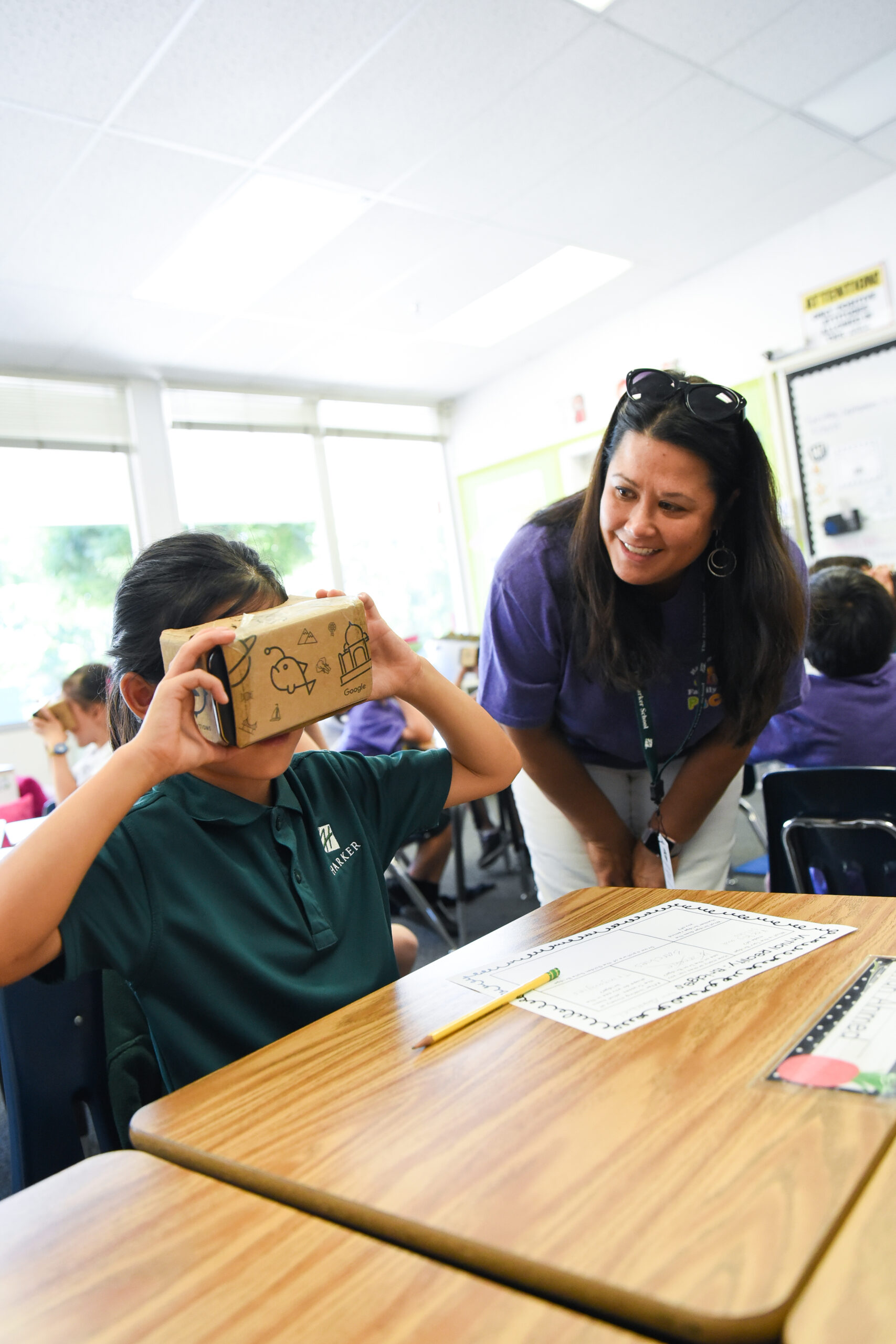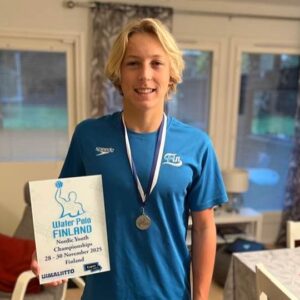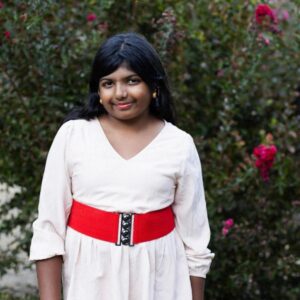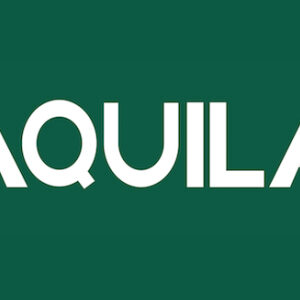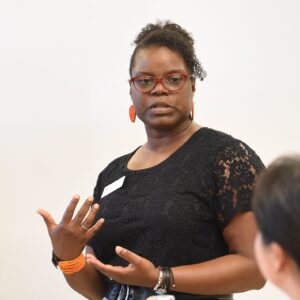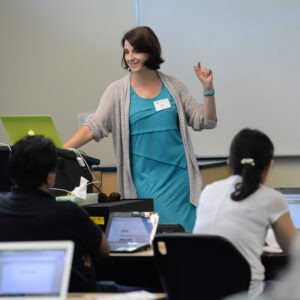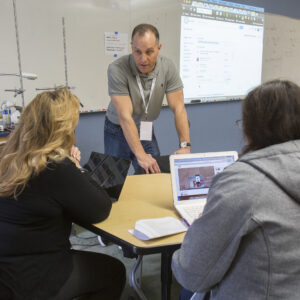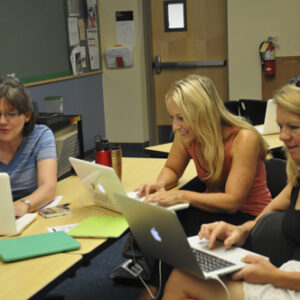This story originally appeared in the Fall/Winter 2019 issue of Harker Magazine.
Aside from having one the school’s catchier acronyms, Harker’s learning, innovation and design (LID) department has for years been a key driver of much of the technology and methods that have made the school’s classroom experience continually exceptional. But there’s far more to LID’s process and philosophy than the latest device or app fashionable among teachers.
Harker has long been a tech-savvy school, partly owing to its roots in Silicon Valley. Student-built apps are in regular use on campus, and clubs host multiple programming competitions each year. Laptops see ubiquitous use by students and faculty for every kind of assignment, and teachers have made use of funds provided through the school’s LID Grant (formerly Tech Grant) program to explore new ways to integrate the latest technology into their instructional methods.
It wasn’t until relatively recently, however, that Harker took the crucial institutional step to decouple classroom innovation from the realm of information technology, a distinction that LID directors are hoping will become clearer in the future. “In the larger scope of education, innovation and educational technology, there was a significant shift away from associating what we do with the boxes and wires, the technical aspects of technology,” said Liz Brumbaugh, PS-12 LID director. “We provide the support for faculty to integrate whatever innovations, whatever creativity, whatever design pieces – whether that’s lesson design or their environmental design – and walk next to them in the development of whatever cool, great, inspiring new thing they want to try.”
Although these ideas may (and frequently do) incorporate a piece of technology, gadgets and software are no longer seen by LID as an essential piece of the puzzle. “Sometimes a crayon’s the best tool,” said Brumbaugh. Should a tech tool turn out to be more suitable than a crayon, LID takes steps to ensure that it’s a better fit for a teacher’s pedagogical approach, and that it is not being implemented for the sake of having a nice new toy to play with. “The technology that’s pervasive is another tool,” said Brumbaugh. “It’s an impactful tool, but you have to look at your lesson design. What’s your purpose? What’s your point in your lesson first? And then backwards plan and say, ‘Is technology the point of this?’”
Key to each LID director’s position is the requirement that they also have experience as classroom teachers, which offers unique insight into the day-to-day lives and activities of the educators they work with, in addition to familiarizing them with pedagogical theory.
“We have spent a lot of time teaching and being around teachers and learning about what makes good teaching even better,” said Diane Main, LID director at the upper school. “Many times when teachers have me come work with them or their students, or both, it’s not necessarily about technology, it’s about how we can do a better job of what we’re trying to do in that learning experience.”
To that end, teachers often see LID as a great source of feedback on their ideas, and have emerged from their discussions with LID inspired and invigorated. “The most important role that Lisa [Diffenderfer, lower school LID director,] plays for me is as a sounding board for helping me discern the best approach to designing lessons and activities,” said grade 5 English teacher Ann Smitherman. “She helps me determine what I really want to teach my students, and in turn, how I really want my students to show me what they’ve learned.”
Diffenderfer’s work has been instrumental in introducing virtual reality lessons to lower school classrooms, enabling students to, among other things, get detailed glimpses of far-off places relevant to their studies. She has been working with teachers to formulate ways to “take it a step further, helping teachers create their own virtual reality experiences for the students, more specific experiences that relate to the content of their classrooms,” she said.
When Smitherman wanted to use VR in her classroom as part of a unit on E.L. Konigsburg’s 1967 novel “From the Mixed-Up Files of Mrs. Basil E. Frankweiler,” Diffenderfer worked with her “to create a Google Slides ‘journey’ that helped students explore such old-timey landmarks as the automat and Grand Central Station,” she recalled. “Students were able to work at their own pace to complete the work, and it made the literature come to life.”
Another, less technology-focused project was spurred by Smitherman’s session at the Teachers College Reading and Writing Project at Columbia University last year, aimed at developing reading and writing skills in young students by creating new methods for teaching and assessment. Smitherman returned from the two-week session with an idea for a new writing program that is currently being piloted among a self-selected group of teachers. Diffenderfer and Smitherman have worked closely to develop the pilot program “in a more organized and research-based fashion,” Diffenderfer said.
This particular project is one where Diffenderfer’s experience as a teacher has proved crucial. “Lisa has a great understanding of our curriculum, knows the ‘latest and greatest’ tools – not all of which require technology – to help me and our students reach our goals,” said Smitherman. “She asks really probing questions, forcing me to clarify the outcomes I seek.”
In addition to academics, LID also has applied its expertise to areas such as digital citizenship, student wellness and social justice. Earlier this year, middle school history teacher Cyrus Merrill and middle school LID director Abigail Joseph worked together to create a “social justice hackathon for students to take on real-world challenges and attempt to put together potential real-world solutions,” Merrill said. “I want to empower students to think they themselves can take on issues in the present, not just learn about them in the past.”
The result of that collaboration is the Get MAD (Make A Difference) design workshop and hackathon, which took place in November and saw students organize into groups to develop ideas to combat various social problems using their creativity and design thinking, a method of problem-solving that involves ascertaining a greater sense of who will be seeing and using the things they’ve made.
Joseph also worked with several teachers who attended the Institute for Social and Emotional Learning this past summer. “I helped them debrief to generate ideas for their actionable next steps,” Joseph said. “So I led them through a two-hour design thinking process, and at the end of that they came up with two concrete ideas that they wanted to bring back to staff and the parent community around introducing SEL at Harker.”
Design thinking is popular in the maker community, with which Joseph has spent considerable time at meetups and conferences. She runs and curates the middle school’s LID Hub, a maker and design thinking space which she hopes to see become “a space on campus where teachers and students can go and make their ideas take flight and test out things and try developing any ideas or thoughts that they have.”
Joseph one day would like to have students and teachers working together in the LID Hub, and to have the students become experienced enough to offer lessons of their own. “My big vision is to have the students teach the teachers,” she said.
In the meantime, teachers have spent a lot of time teaching one another during the LID Vision Days that are held each year, in which they share new methods or concepts they have integrated into their instruction, often as a result of the LID Grant program. Ostensibly an opportunity for teachers to find new ways to enhance their methods, LID Vision Days have also acted as forums for teachers to brainstorm and discuss a wide range of topics that affect learners.
“It’s really about the other people in the room getting a chance to learn and/or participate. It’s not always what we could call a sit-and-get kind of thing, where the teacher teaches and everybody just learns something,” said Main. “Often it’s hands on, it’s ‘Why don’t you bring your laptop and we’ll go through this together?’ or a conversation where the person facilitating is really just the one starting the conversation, and it doesn’t have to be that they’re leading it.”
One session took the form of a discussion on how to teach girls and how teachers often unknowingly carry gender-based biases with them into the classroom. “There’s a lot of implicit bias towards males in the classroom; there are certain behaviors that tend to be seen as more masculine that are seen as more favorable,” said Main.
In another session facilitated by Main and upper school Spanish teacher Abel Olivas, students from the Gender and Sexuality Alliance invited teachers to ask questions about the experiences of LGBTQ+ students, including topics such as gender-neutral restrooms, how to ask students about correct pronoun usage and avoiding the use of everyday gendered phrases such as “you guys.”
“Those conversations have been exciting to be a part of because they’re a part of our culture here and not just about our job,” Main said. “That’s what LID wants to be about, is helping transform the culture of the school so that everyone feels like it’s a very comfortable, safe, positive learning space.”
Earlier this year, Joseph spearheaded the effort to help make LID Vision Days even more student-focused with the first Student LID Vision. “I thought, well why don’t students have an opportunity to showcase all the cool learning that they do in and outside of the classroom, because they all do so much?” she recalled. The event showcased the engaging aspects of everything from debate to origami to yearbook signing, mirroring LID’s philosophy that learning can take many unlikely forms.
“Providing that space for our students to start having a little bit of voice and choice and to recognize that their learning can happen beyond their classroom is probably the thing I’m most proud of,” Joseph said. “I’m looking forward to making that bigger and better than last year and utilizing some faculty and students to help design what it looks like.”
To this end, Joseph is planning to form student and faculty LID councils that meet separately to discuss LID’s impact on the school community. Brumbaugh is also hoping to bring teachers who’ve worked with LID to conferences and co-present with them about ways they’ve applied learning, innovation and design principles in their teaching methods. Although Harker has hosted and invited teachers from outside the school to events such as the Harker Teacher Institute, such events have become extremely common.
“Conferences are a dime a dozen, especially in this area and especially as it relates to educational technology,” Brumbaugh said. “It’s almost impossible not to find some weekend throughout the entire year where people could go to a conference within 20 miles and get some educational technology training.” The addition of online resources such as YouTube channels and podcasts, she added, makes it more difficult for events such as the Harker Teacher Institute to set themselves apart.
As an alternative to overcrowding the selection of events, LID began requesting teachers to submit proposals last spring for presentations on how they’ve worked with LID to expand or strengthen their methods, which the LID directors plan to craft together with the teachers. For teachers more reticent about presenting on their achievements, LID directors have offered to present with them. “Teachers are notoriously humble, and because they’re notoriously humble, they don’t toot their own horns,” Brumbaugh said. “But if you can say there are people who need to learn a thing, they’ll be motivated by that.”
Meanwhile, the directors themselves are always seeking opportunities for new methods and technologies to bring to their colleagues. Next year, they plan to attend SXSW Edu, the educational arm of the world-famous SXSW culture festival in Austin. “We all go out to these different education innovation-rich conferences to keep up with the landscape of how people are innovating in education,” Joseph said.
According to Brumbaugh – who started in education as an English teacher and previously worked at the Santa Clara County Office of Education as instructional technology manager, serving more than 200,000 students – Harker is in a unique position to lead in a developing field. “The fact that we have the people in the first place sets us apart, but then that we have pretty high standards for what those people are going to be able to do once they’re in this position, is another level altogether,” she said. “So I think what sets us apart is the structure, which is representative of the philosophy, and the individual people. There’s such synchronicity, and it’s really beautiful when I stand back from being in the team and I’m like, this is good.”
